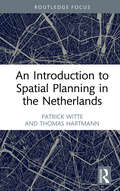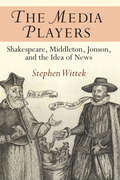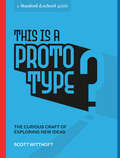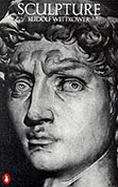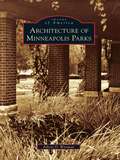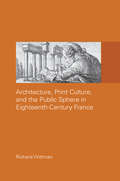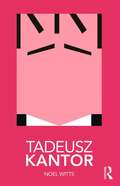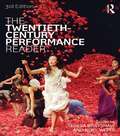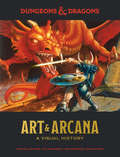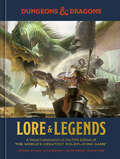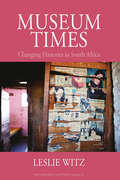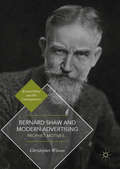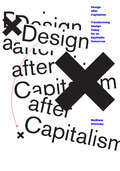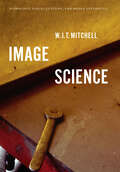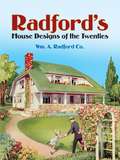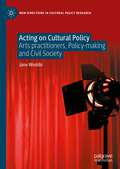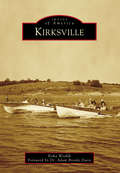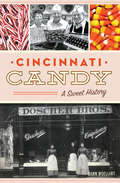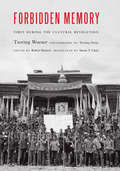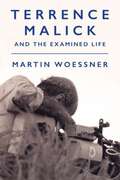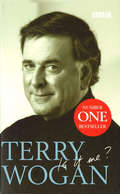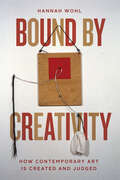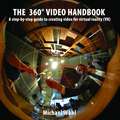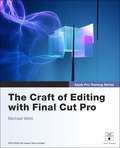- Table View
- List View
An Introduction to Spatial Planning in the Netherlands
by Patrick Witte Thomas HartmannThis book provides an introduction to spatial planning in the Netherlands. It explores the academic underpinnings of the discipline and its practical implications, making use of insights on planning practices from the Netherlands. As an academic book with relevance for spatial planning teaching and practice, the relation between planning practice and planning as an academic discipline are discussed. A key analytical concept is introduced to discuss the different dimensions of planning: the planning triangle. This framework helps to bridging the strategic and conceptual elements of planning with its realization. The object, process and context of planning and its relations are discussed. The core of the academic discipline and profession of spatial planning entails looking (far) into the future, stimulating discussion, formulating a desired future direction through an informal and collective planning process and then formalizing and placing current action into that future perspective. In that sense, spatial planning can be understood as the strategic organisation of hopes and expectations. As a study book it is suitable for students of planning at various universities, but also for students in higher professional education. For those involved in the professional field of spatial planning, this book offers a sound foundation.
The Media Players
by Stephen WittekThe Media Players: Shakespeare, Middleton, Jonson, and the Idea of News builds a case for the central, formative function of Shakespeare's theater in the news culture of early modern England. In an analysis that combines historical research with recent developments in public sphere theory, Dr. Stephen Wittek argues that the unique discursive space created by commercial theater helped to foster the conceptual framework that made news possible. Dr. Wittek's analysis focuses on the years between 1590 and 1630, an era of extraordinary advances in English news culture that begins with the first instance of serialized news in England and ends with the emergence of news as a regular, permanent fixture of the marketplace. Notably, this period of expansion in news culture coincided with a correspondingly extraordinary era of theatrical production and innovation, an era that marks the beginning of commercial theater in London, and has left us with the plays of William Shakespeare, Ben Jonson, and Thomas Middleton. Book jacket.
This Is a Prototype: The Curious Craft of Exploring New Ideas (Stanford d.school Library)
by Scott Witthoft Stanford d.schoolA practical guide to prototyping as a way to revolutionize your work and creative life, from Stanford University's world-renowned Hasso Plattner Institute of Design, aka the d.school.Prototyping is a way to test an idea to see if it can be successful before investing too much time and too many resources. But it's not only designers who "prototype" as they work. A skateboarder tries a new trick; that's a prototype experience. A chef experiments with a new dish and new ingredients; that's a prototype experience, too. Once a prototype is made, the creator gains knowledge about what worked and what didn't, what should be used again and what should be trimmed from the experience. This is a book about becoming better at prototyping by building things and experiences that will help you learn from your attempts, no matter what you're aiming to achieve. Readers will learn how to not only create prototypes but also how to reflect on the success and failure of those attempts. Scott Witthoft, who teaches courses in design and prototyping to students around the world, introduces a comprehensive number of tools and materials for prototyping, including digital platforms and physical objects. And he breaks down real-life examples of prototype experiments with accompanying photographs for the reader to observe large- and small-scale prototyping in action. With Witthoft as your guide, you'll put the principles of design into practice and bring your vision to life—one prototype at a time.
Sculpture: Processes and Principles
by Rudolf WittkowerThis book studies what unites and separates sculptors across the centuries. It looks at the masters of Archaic Greece, the Middle Ages, through the great names of Michelangelo, Cellini and Bernini to Rodin, Brancusi and Henry Moore. By studying their working methods and techniques, the author discloses their artistic ideas and convictions, thereby opening up new avenues of approach for the spectator.
Architecture of Minneapolis Parks (Images of America)
by Albert D. WittmanBuildings, bridges, and much more--these are the treasures in or near Minneapolis parks that are rarely given attention. This book diverts the reader from the traditional park elements of lakes, woods, streams, and playfields and focuses instead on the rich architectural components they offer. Buildings range from the 160-year-old Godfrey house, believed to be the oldest standing house in Minneapolis, to the recently completed shelters in the Wabun picnic area at Minnehaha Park. Many architects, from Stanford White to Harry Jones to Frank Gehry, have left their marks either on parkland or across the street. Some of their notables are presented in this book. One of the most popular icons of Minneapolis, the Lake Harriet Bandstand, with a long list of predecessors and once painted blue, rounds out this presentation.
Architecture, Print Culture and the Public Sphere in Eighteenth-Century France (The Classical Tradition in Architecture)
by Richard WittmanThis book focuses on the complex ways in which architectural practice, theory, patronage, and experience became modern with the rise of a mass public and a reconfigured public sphere between the end of the seventeenth century and the French Revolution. Presenting a fresh theoretical orientation and a large body of new primary research, this book offers a new cultural history of virtually all the major monuments of eighteenth-century Parisian architecture, with detailed analyses of the public debates that erupted around such Parisian monuments as the east facade of the Louvre, the Place Louis XV [the Place de la Concorde], and the church of Sainte-Genevieve [the Pantheon]. Depicting the passage of architecture into a mediatized public culture as a turning point, and interrogating it as a symptom of the distinctly modern configuration of individual, society, and space that emerged during this period, this study will interest readers well beyond the discipline of architectural history.
Tadeusz Kantor (Routledge Performance Practitioners)
by Noel WittsTadeusz Kantor – a theoretician, director, innovator and painter famed for his very visual theatre style – was a key figure in European avant-garde theatre. He was also known for his challenging theatrical innovations, such as extending stages and the combination of mannequins with living actors. The book combines: a detailed study of the historical context of Kantor’s work an exploration of Kantor’s own writings on his theatrical craft a stylistic analysis of the key works, including The Dead Class and Let the Artists Die, and their critical reception an examination of the practical exercises devised by Kantor. As a first step towards critical understanding, and as an initial exploration before going on to further, primary research, Routledge Performance Practitioners offer unbeatable value for today’s student.
The Twentieth Century Performance Reader
by Noel Witts Teresa BrayshawThe Twentieth-Century Performance Reader has been the key introductory text to all types of performance for over fifteen years. Extracts from over fifty practitioners, critics and theorists from the fields of dance, drama, music, theatre and live art form an essential sourcebook for students, researchers and practitioners. This carefully revised third edition offers focus on contributions from the world of music, and also privileges the voices of practitioners themselves ahead of more theoretical writing. A bestseller since its original publication in 1996, this new edition has been expanded to include contributions from: Bobby Baker; Joseph Beuys; Rustom Bharucha; Anne Teresa de Keersmaeker; Hanns Eisler; Karen Finley; Philip Glass; Guillermo Gómez-Peña; Matthew Goulish; Martha Graham; Wassily Kandinsky; Jacques Lecoq; Hans-Thies Lehmann; George Maciunas; Ariane Mnouchkine; Meredith Monk; Lloyd Newson; Carolee Schneemann; Gertrude Stein; Bill Viola. Each extract is fully supplemented by a contextual summary, a biography of the writer, and suggestions for further reading. The volume's alphabetical structure invites the reader to compare and cross-reference major writings on all types of performance outside of the constraints and simplifications of genre, encouraging cross-disciplinary understandings. All who engage with live, innovative performance, and the interplay of radical ideas, will find this collection invaluable.
Dungeons & Dragons Art & Arcana: A Visual History (Dungeons & Dragons)
by Michael Witwer Kyle Newman Jon Peterson Sam Witwer Official Dungeons & Dragons LicensedAn illustrated guide to the history and evolution of the beloved role-playing game told through the paintings, sketches, illustrations, and visual ephemera behind its creation, growth, and continued popularity.FINALIST FOR THE HUGO AWARD • FINALIST FOR THE LOCUS AWARD • NOMINATED FOR THE DIANA JONES AWARDFrom one of the most iconic game brands in the world, this official DUNGEONS & DRAGONS illustrated history provides an unprecedented look at the visual evolution of the brand, showing its continued influence on the worlds of pop culture and fantasy. Inside the book, you&’ll find more than seven hundred pieces of artwork—from each edition of the core role-playing books, supplements, and adventures; as well as Forgotten Realms and Dragonlance novels; decades of Dragon and Dungeon magazines; and classic advertisements and merchandise; plus never-before-seen sketches, large-format canvases, rare photographs, one-of-a-kind drafts, and more from the now-famous designers and artists associated with DUNGEONS & DRAGONS. The superstar author team gained unparalleled access to the archives of Wizards of the Coast and the personal collections of top collectors, as well as the designers and illustrators who created the distinctive characters, concepts, and visuals that have defined fantasy art and gameplay for generations. This is the most comprehensive collection of D&D imagery ever assembled, making this the ultimate collectible for the game's millions of fans around the world.
Lore & Legends: A Visual Celebration of the Fifth Edition of the World's Greatest Roleplaying Game (Dungeons & Dragons) (Dungeons & Dragons)
by Michael Witwer Kyle Newman Jon Peterson Sam Witwer Official Dungeons & Dragons LicensedAn illustrated guide to Dungeons & Dragons&’ beloved fifth edition told through interviews, artwork, and visual ephemera from the designers, storytellers, and artists who bring it to life. When the reimagined fifth edition of Dungeons & Dragons debuted in the summer of 2014, the game was on the brink of obsolescence. But within a few short years, D&D found greater success than it had ever enjoyed before, even surpassing its 1980s golden age. How did an analog game nearly a half century old become a star in a digital world? For the first time, Lore & Legends reveals the incredible ongoing story of Dungeons & Dragons fifth edition from the perspective of the designers, artists, and players who bring it to life. This comprehensive visual guide illuminates contemporary D&D—its development, evolution, cultural relevance, and popularity—through exclusive interviews and more than 900 pieces of artwork, photography, and advertising curated and analyzed by the authors of the bestselling and Hugo Award–nominated Dungeons & Dragons Art & Arcana.
Museum Times: Changing Histories in South Africa (Museums and Collections #16)
by Leslie WitzMuseums flourished in post-apartheid South Africa. In older museums, there were renovations on the go, and at least fifty new museums opened. Most sought to depict violence and suffering under apartheid and the growth of resistance. These unlikely journeys are tracked as museums became a primary setting for contesting histories. From the renowned Robben Island Museum to the almost unknown Lwandle Migrant Labour Museum, the author demonstrates how an institution concerned with the conservation of the past is simultaneously a site for changing history.
Bernard Shaw and Modern Advertising: Prophet Motives (Bernard Shaw and His Contemporaries)
by Christopher WixsonThis book charts how promotional campaigns in which Bernard Shaw participated were key crucibles within which agency and personality could re-negotiate their relationship to one another and to the consuming public. Concurrent with the rise of modern advertising, the creation of Shaw’s 'G.B.S.' public persona was achieved through masterful imitation of patent medicine marketing strategies and a shrewd understanding of the relationship between product and spokesman. Helping to enhance the visibility of his literary writing and dovetailing with his Fabian political activities, 'G.B.S.' also became a key figure in the evolution of testimonial endorsement and the professionalizing of modern advertising. The study analyzes multiple ad series in which Shaw was prominently featured that were occasions for self-promotion for both Shaw and the agencies, and presage the iconoclastic style of contemporary 'public personality' and techniques of celebrity marketing.
Design after Capitalism: Transforming Design Today for an Equitable Tomorrow
by Matthew WizinskyHow design can transcend the logics, structures, and subjectivities of capitalism: a framework, theoretical grounding, and practical principles.The designed things, experiences, and symbols that we use to perceive, understand, and perform our everyday lives are much more than just props. They directly shape how we live. In Design after Capitalism, Matthew Wizinsky argues that the world of industrial capitalism that gave birth to modern design has been dramatically transformed. Design today needs to reorient itself toward deliberate transitions of everyday politics, social relations, and economies. Looking at design through the lens of political economy, Wizinsky calls for the field to transcend the logics, structures, and subjectivities of capitalism—to combine design entrepreneurship with social empowerment in order to facilitate new ways of producing those things, symbols, and experiences that make up everyday life. After analyzing the parallel histories of capitalism and design, Wizinsky offers some historical examples of anticapitalist, noncapitalist, and postcapitalist models of design practice. These range from the British Arts and Crafts movement of the nineteenth century to contemporary practices of growing furniture or biotextiles and automated forms of production. Drawing on insights from sociology, philosophy, economics, political science, history, environmental and sustainability studies, and critical theory—fields not usually seen as central to design—he lays out core principles for postcapitalist design; offers strategies for applying these principles to the three layers of project, practice, and discipline; and provides a set of practical guidelines for designers to use as a starting point. The work of postcapitalist design can start today, Wizinsky says—with the next project.
Image Science: Iconology, Visual Culture, and Media Aesthetics
by W.J.T. MitchellAlmost thirty years ago, W. J. T. Mitchell's Iconology helped launch the interdisciplinary study of visual media, now a central feature of the humanities. Along with his subsequent Picture Theory and What Do Pictures Want?, Mitchell's now-classic work introduced such ideas as the pictorial turn, the image/picture distinction, the metapicture, and the biopicture. These key concepts imply an approach to images as true objects of investigation--an "image science. " Continuing with this influential line of thought, Image Science gathers Mitchell's most recent essays on media aesthetics, visual culture, and artistic symbolism. The chapters delve into such topics as the physics and biology of images, digital photography and realism, architecture and new media, and the occupation of space in contemporary popular uprisings. The book looks both backward at the emergence of iconology as a field and forward toward what might be possible if image science can indeed approach pictures the same way that empirical sciences approach natural phenomena. Essential for those involved with any aspect of visual media, Image Science is a brilliant call for a method of studying images that overcomes the "two-culture split" between the natural and human sciences.
Radford's House Designs of the Twenties
by Wm. A. Radford Co.Created as an aid to architects, carpenters, and builders, this Radford Architectural Company of Chicago catalog was also welcomed by future home owners. Included are such houses as the Bixby, a two-bedroom bungalow, the Coventry, a charming Dutch Colonial with three bedrooms and other accommodations, and more. 189 black-and-white illustrations.
Acting on Cultural Policy: Arts Practitioners, Policy-Making and Civil Society (New Directions in Cultural Policy Research)
by Jane WoddisThis book investigates the role of arts practitioners in cultural policy-making, challenging the perception that arts practitioners have little or no involvement in policy and seeking to discover the extent and form of their engagement. Examining the subject through a case-study of playwriting policy in England since 1945, and paying particular attention to playwrights’ organisations and their history of self-directed activity, the book explores practitioners’ participation in cultural policy-making, encompassing both “invited” and “uninvited” interventions that also weave together policy activity and creative practice. It discusses why their involvement matters, and argues that arts practitioners and their organisations can be understood as participants in civil society whose policy activity contributes to the maintenance and enlargement of democratic practices and values.
Kirksville
by Erika WoehlkKirksville has made a name for itself with its two major institutions of higher education--Truman State University and A.T. Still University--that attract bright students from all over the world. Incorporated in 1857, it has grown to become the most populous city in northeast Missouri. As the seat of government for Adair County, the courthouse stands proudly in the center of the business square downtown. Entrepreneurs have benefited from railroad lines that entered the town in the 1870s, and many businesses have flourished in Kirksville as a result. Residents braved the tumultuous Civil War and rebuilt the town after major tornadoes and ice storms. Kirksville is a beautiful place to live, as exemplified by nearby Thousand Hills State Park. It is indeed the town "where people make the difference."
Cincinnati Candy: A Sweet History
by Dann WoellertFor more than a century, Cincinnati’s candy industry satisfied our national sweet tooth. Stick and drop candies appeared here long before their Civil War popularity. Opera creams, rich fondant-filled chocolate candy brought here by Robert Hiner Putman, provided decadence. Candy corn, which the Goelitz Company introduced to the United States before World War I, remains a ubiquitous treat. Marpro Products created and popularized the marshmallow cone candy. Doscher invented the French Chew and made caramel corn a baseball concession at Redland Field decades before Cracker Jack became synonymous with our national pastime. The city’s many Greek and Macedonian immigrants influenced the unique Queen City tradition of finishing a Cincinnati-style “threeway” of spaghetti, chili and cheddar with a chocolate mint. Local food etymologist Dann Woellert tells these stories and more in this delectably sweet history.
Forbidden Memory: Tibet during the Cultural Revolution
by Tsering WoeserWhen Red Guards arrived in Tibet in 1966, intent on creating a classless society, they unleashed a decade of revolutionary violence, political rallies, and factional warfare marked by the ransacking of temples, the destruction of religious artifacts, the burning of books, and the public humiliation of Tibet&’s remaining lamas and scholars. Within Tibet, discussion of those events has long been banned, and no visual records of this history were known to have survived. In Forbidden Memory the leading Tibetan writer Tsering Woeser presents three hundred previously unseen photographs taken by her father, then an officer in the People&’s Liberation Army, that show for the first time the frenzy and violence of the Cultural Revolution in Tibet. Found only after his death, Woeser&’s annotations and reflections on the photographs, edited and introduced by the Tibet historian Robert Barnett, are based on scores of interviews she conducted privately in Tibet with survivors. Her book explores the motives and thinking of those who participated in the extraordinary rituals of public degradation and destruction that took place, carried out by Tibetans as much as Chinese on the former leaders of their culture. Heartbreaking and revelatory, Forbidden Memory offers a personal, literary discussion of the nature of memory, violence, and responsibility, while giving insight into the condition of a people whose violently truncated history they are still unable to discuss today.Access the glossary.
Terrence Malick and the Examined Life (Intellectual History of the Modern Age)
by Martin WoessnerTerrence Malick is one of American cinema’s most celebrated filmmakers. His films—from Badlands (1973) and Days of Heaven (1978) to The Thin Red Line (1998), The Tree of Life (2011), and, most recently, A Hidden Life (2019)—have been heralded for their artistry and lauded for their beauty, but what really sets them apart is their ideas. Terrence Malick and the Examined Life is the most comprehensive account to date of this unparalleled filmmaker’s intellectual and artistic development.Utilizing newly available archival sources to offer original interpretations of his canonical films, Martin Woessner illuminates Malick’s early education in philosophy at Harvard and Oxford as well as his cinematic apprenticeship at the American Film Institute to show how a young student searching for personal meaning became a famous director of Hollywood films. Woessner’s book presents a rich, interdisciplinary exploration of the many texts, thinkers, and traditions that made this transformation possible—from the novels of Hamlin Garland, James Jones, and Walker Percy to the philosophies of Stanley Cavell, Martin Heidegger, and Søren Kierkegaard to road movies, Hollywood Westerns, and the comedies of Jean Renoir. Situating Malick’s filmmaking within recent intellectual and cultural history, Woessner highlights its lasting contributions to both American cinema and the life of the mind.Terrence Malick and the Examined Life suggests it is time for philosophy to be viewed not merely as an academic subject, overseen by experts, but also as a way of life, open to each and every moviegoer.
Hollywood Blockbusters: The Anthropology of Popular Movies
by Peter Wogan David SuttonCertain Hollywood movies are now so deeply woven into the cultural fabric that lines of their dialogue - for example, 'Make him an offer he can't refuse' - have been incorporated into everyday discourse. The films explored in this book, which include The Godfather, Jaws, The Big Lebowski, Field of Dreams and The Village, have become important cultural myths, fascinating windows into the schisms, tensions, and problems of American culture. Hollywood Blockbusters: The Anthropology of Popular Movies uses anthropology to understand why these movies have such enduring appeal in this age of fragmented audiences and ever-faster spin cycles. Exploring key anthropological issues from ritual, kinship, gift giving and totemism to literacy, stereotypes, boundaries and warfare, this fascinating book uncovers new insights into the significance of modern film classics for students of Film, Media, Anthropology and American Cultural Studies.
Terry Wogan - Is it me?
by Terry WoganTerry Wogan was one of Britain's best-loved radio and television celebrities witty, charming and relaxed and undoubtedly captured the nation's heart. Here, Terry tells his life story from his beginnings as a young Limerick boy to his incredible success as an enduring celebrity with shows such as Wogan and The Eurovision Song Contest. Is It Me? is written in Terry's own inimitable style, with self-deprecating humour and a wry take on everyday life. The story is a delightfully observed, light-hearted journey through Terry's personal and professional lives. After reluctantly starting his career in banking, Terry escaped to make a sucessful break into broadcasting with RTE. Fronting Children in Need, Wogan and The Eurovision Song Contest and collecting millions of listeners to his morning BBC 2 radio show, Wake Up To Wogan, he is now the most prolific and popular presenter at the BBC. 'I am sure it's a challenging read' Sir David Frost 'I don't remember him' Jimmy Young
Bound by Creativity: How Contemporary Art Is Created and Judged
by Hannah WohlWhat is creativity? While our traditional view of creative work might lead us to think of artists as solitary visionaries, the creative process is profoundly influenced by social interactions even when artists work alone. Sociologist Hannah Wohl draws on more than one hundred interviews and two years of ethnographic research in the New York contemporary art market to develop a rich sociological perspective of creativity. From inside the studio, we see how artists experiment with new ideas and decide which works to abandon, destroy, put into storage, or exhibit. Wohl then transports readers into the art world, where we discover how artists’ understandings of their work are shaped through interactions in studio visits, galleries, international art fairs, and collectors’ homes. Bound by Creativity reveals how artists develop conceptions of their distinctive creative visions through experimentation and social interactions. Ultimately, we come to appreciate how judgment is integral to the creative process, both resulting in the creation of original works while also limiting an artist’s ability to break new ground. Exploring creativity through the lens of judgment sheds new light on the production of cultural objects, markets, and prestige.
The 360° Video Handbook: A Step-by-step Guide to Creating Video for Virtual Reality (VR)
by Michael WohlA practical hands-on guidebook for producers, directors, cinematographers, sound recordists, and editors interested in creating 360-degree video. Coursing an easy-to-follow trail through the thicket of technobabble and jargon, The book provides nuts-and-bolts recommendations on everything from the selection of cameras, microphones and editing tools to aesthetic and creative decisions such as camera placement and blocking, as well as editing, incorporating titles, transitions, andother effects.
Apple Pro Training Series: The Craft of Editing with Final Cut Pro
by Michael WohlIn this Apple-authorized training book, director and filmmaker Michael Wohl delivers comprehensive training in the real-world skills editing pros use every day in the field. This is the ideal curriculum for a hands-on exploration of advanced editing with Final Cut Pro 6.
